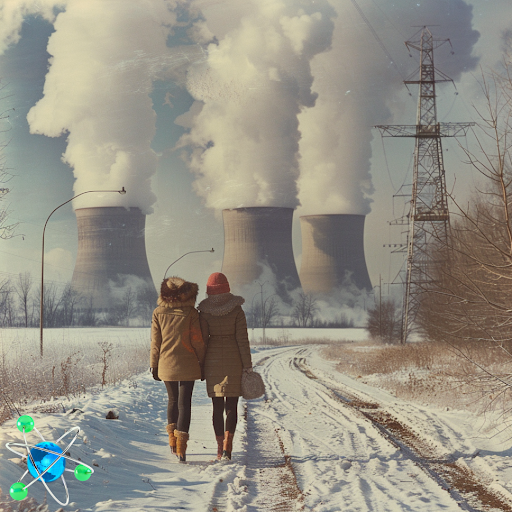
- Nuclear Plant Closures and Reopenings: Since 2013, numerous U.S. nuclear plants have shut down due to competition from natural gas and rising safety costs, risking increased fossil fuel usage. Efforts are underway to revive retired plants, like the Palisades reactor in Michigan, to support clean energy goals.
- Challenges and Strategies: High costs hinder new nuclear plant construction, prompting Energy Secretary Jennifer Granholm to focus on adding reactors to existing sites. Approximately 30 sites are licensed for new reactors to boost generation capacity and aid decarbonization by 2050.
- Federal and State Support: Federal initiatives like the Inflation Reduction Act and CHIPS and Science Act provide tax credits and funding for nuclear research. States such as California, Connecticut, Illinois, and New Jersey are subsidizing existing plants and exploring small modular reactors for sustainable energy solutions.
Since 2013, around a dozen U.S. nuclear power plants have shut down due to competition from natural gas fired power and increasing costs of safety measures. However nuclear provides 18% of the nation’s electricity. The closure of nuclear plants could lead to an expansion of fossil fuel-powered replacements, worsening our climate problem. Energy Secretary Jennifer Granholm, shares what could be to come in terms of reviving retired nuclear plants, or adding new reactors to existing plants in efforts to achieve zero-emission electricity.
The high costs of new nuclear plant construction is the dominant obstacle in greenhouse gas reduction goals and decarbonizing the economy by 2050. With no new construction of nuclear plants in the United States, Granholm is emphasizing building new reactors at existing sites to “use the existing footprint to be able to increase generation capacity.” She said about 30 power plant sites across the U.S. have been licensed or permitted for the construction of more reactors.
Picking Up Palisades
The Department of Energy’s Loan Programs Office (LPO) in March issued a $1.52 billion conditional loan to Holtec International (owner of the plant) to reopen the shut Palisades reactor in Michigan, which could become the first nuclear plant in the country to restart after being shuttered. The plant, which closed in 2022, now needs approval from the Nuclear Regulatory Commission, which oversees nuclear safety.
When Palisades closed amid financial struggles in 2022, it represented roughly 5% of Michigan’s electricity supply. That has been replaced largely with natural gas generation, Cook said. The expansion of fossil fuel-based power conflicts with legislation passed last year requiring the state to move to 100% clean energy by 2040.
“This is really an all-hands-on-deck approach,” said Cook, citing the hundreds of union jobs that could return to the region if the plant reopens. She said the state funding was critical to show both Holtec and federal officials that there was strong support in Michigan to save Palisades.
“With the amount of money that’s gone into this [Palisades] restart scheme already, you could develop brand-new renewable energy proposals that would be online in the same time frame producing more electricity,” said Kevin Kamps, radioactive waste specialist at Beyond Nuclear, an environmental nonprofit that opposes nuclear energy.
Federal Advocacy
The group of climate, science and energy policy experts from White House and Department of Energy will work with project developers, engineering, procurement and construction firms, utilities, investors, labor organizations, academics, and non-governmental organizations.
Small modular reactors and microreactors can provide energy that is more resilient to physical and cyber attacks, natural disasters and other challenges, the White House said. The Department of Energy also released a paper outlining the expected increased safety of advanced reactors. And a new tool will help developers figure out how to cut capital costs for new nuclear reactors.
The Inflation Reduction Law Act in 2022 is one of the most significant climate change legislation tactics in history. It opened tax credits for new and existing nuclear plants, designed to incentivize clean energy production in the same way existing credits support renewable energy. Since the passage of the tax credits, federal regulators have seen an increased interest from plant operators pursuing license renewals to extend the operating life of their reactors.
Meanwhile, the CHIPS and Science Act passed by Congress also includes funding for federal nuclear research, university programs, new research reactors, isotope production and advanced reactors.
State Advocacy
Palisades is not the only plant receiving a second wave of attention. California received a boost of federal money in an award finalized last month to keep open a nuclear plant run by Pacific Gas and Electric, known as PG&E. Other states, including Connecticut, Illinois and New Jersey, have passed legislation in recent years to provide subsidies for existing nuclear plants.
“A lot of people believe we can power California with renewables alone and batteries,” said Carl Wurtz, executive director of Fission Transition, a pro-nuclear advocacy group. “We’re going to be tied to natural gas indefinitely if we try to do it that way.” Wurtz advocated to extend the life of PG&E’s Canyon nuclear plant which was scheduled to close in 2025. He fought back with the argument that it powered 9% of all of California’s energy, and taking this away would force the importation of more fossil fuels.
Both red and blue states have also taken steps to allow for the development of small modular reactors, an emerging technology that backers say can help to power rural areas or industrial operations without the demands of a large plant. Connecticut, Illinois, Kentucky, Montana, West Virginia and Wisconsin recently repealed bans on adding new nuclear power to enable such reactors.

0 Comments